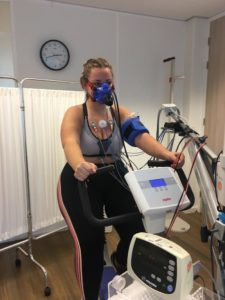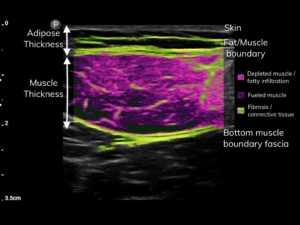Although our last two posts may suggest otherwise, in between all the sightseeing and eating we have actually managed to fit in some work!
We have progressed to starting tests alone and have been given free rein in testing each other and colleagues, which also meant we unfortunately didn’t manage to put off doing our own CPET any longer.
A CPET assess an individual’s heart, lung and muscle function during exercise to identify possible weaknesses within the system. Every client at BeLife undertakes a CPET before their programme, and again at halfway and the end of their programme, which allows us to monitor progress.
The test usually only lasts around 15 minutes during which the client cycles at the same speed as the resistance on the bike increases.
The wires, stickers and tubes are excessive to say the least (there are 21, see below) but serve important functions in allowing us to monitor the function of the heart and lungs during stress.
The data is used to calculate VO2, a measure of the ability of the body to take in and use oxygen during exercise and heart, lung and muscle function collectively. Independent measures of heart and lung function are used to determine possible limiting factors during exercise. These, alongside blood samples allows us to build a better picture of how an individual functions during exercise and create an effective treatment programme.
Kate: Don’t get me wrong, I am more than happy to put someone else through a CPET but doing it myself is a whole other ball game. The worst part is there is nowhere to hide, all your data is right there on the screen. So far, I have done two CPETs, and both have been equally stressful. You might think that knowing exactly what is going to happen would help with nerves, apparently, I am an exception to that rule.
Kate, are you nervous?
- No not too bad
Your heart rate is 135 at rest?
Okay, so maybe I was, just a little bit.
Despite my apparent fear, you can learn a lot about yourself and your health. I started the year relatively healthy, and now have a mildly obstructive lung condition ... and doesn’t everyone know!
Olivia: For anybody who knows me will know that the thought of me doing a CPET is quite laughable, so to say I actually enjoyed (?) the experience is a surprise, even to myself. I do feel like maybe because my results highlighted that I am (surprisingly) quite efficient and all of my graphs looked so beautiful (only something myself and Kate appreciate) the experience was of value. I have done two more CPETs since just to make sure that the results were accurate, and it seems to be the case. But, I’m sure there are plenty more to come …
Testing on ourselves has been an invaluable experience! Comparing our own tests with each other and our first test to the second has been helpful in improving our understanding of the data output and translating this into real life outcomes for the client.
Numbers often don’t really mean much in terms of day to day life, and for some clients the numbers don’t really mean much at all. We have to be able filter the data to select only relevant information and differs depending on whom we are reporting to. This has however, got easier with practice and we now understand 'normal' results and can suggest possible limitations for each individual.
We are also more self-sufficient and proactive in the lab. We know what needs to be done before, during and after a test and take an active role in giving feedback to both clients and colleagues.
Alongside CPET’s we have also started to get to grips with MuscleSound software. This ultrasound technology is a relatively new concept that allows us to gain an insight into muscle condition. A transducer probe creates an ultrasound image to determine glycogen stores and highlight possible muscular imbalances or nutritional deficits. Images can also be used to determine muscle and fat boundaries for body composition, alongside muscle size and catabolism. Although still in development, we have had to opportunity to see this utilised across elite sport, health and critical care environments.
Olivia: Understanding how to use MuscleSound has been interesting to say the least. Firstly, trying to work with the software in Dutch was a challenge in itself before getting technical. We did however realise (after nearly 2 whole days) that we could just change the tablet language settings to English…
We have a basic understanding of the histology of the muscle, however translating this into the image we see on the screen is a different story. It’s a lot of trial and error, every image looks invariably identical to the last, and working out what is what is taking us a little time. But persistence is key and I am sure we will get the hang of it soon.
Scarily, we have reached the halfway mark of our placement this week.
Looking back, we have both gained knowledge, confidence and self-awareness over the last four months which we hope will serve us well beyond both BeLife and Bath.
It is strange to think how much we have changed (for the better we hope) in the past 4 months. You don’t quite realise that there is a huge difference between being an adult at uni and being an adult in the workplace until you become an adult in the workplace.
This new year brings new challenges for the pair of us, but we’re ready as we’ll ever be.
Kate and Liv x
Respond


